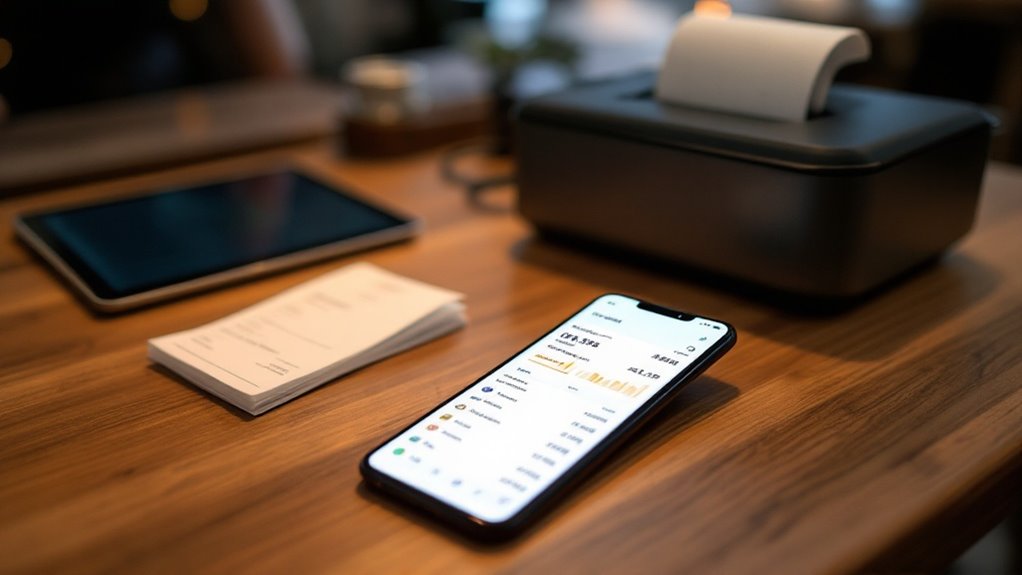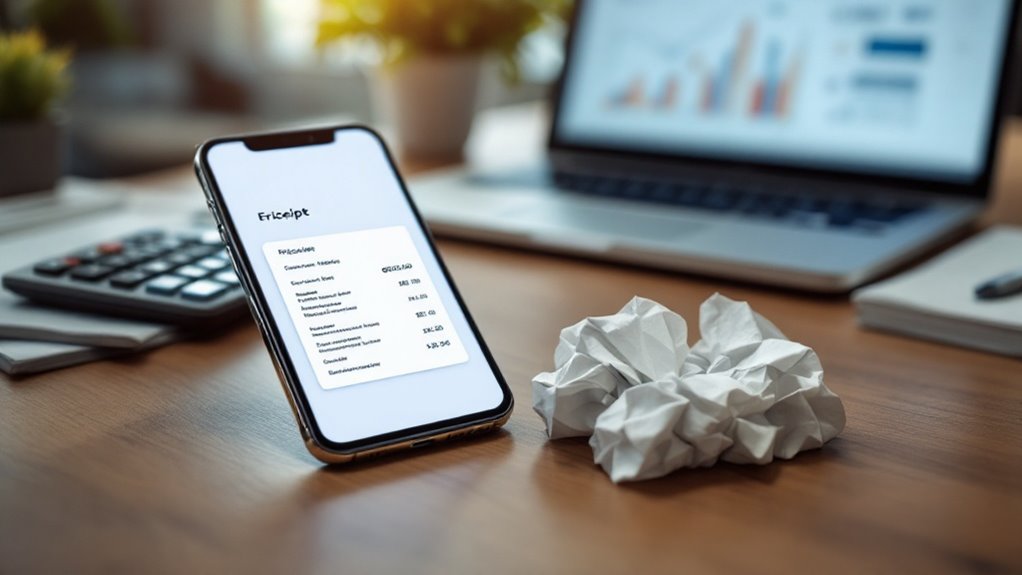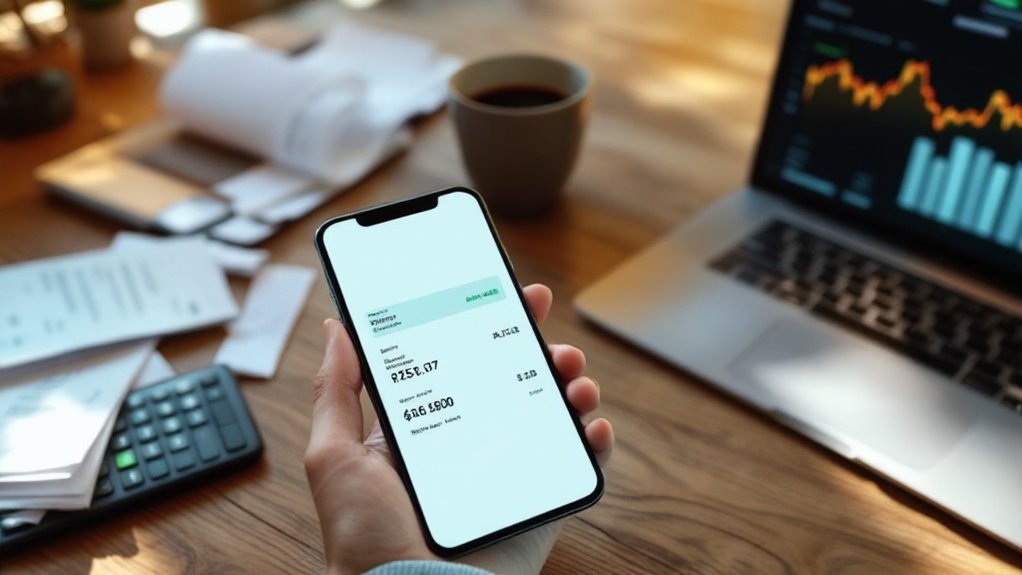Receipt software streamlines expense tracking for small businesses through digital scanning, storage, and organization features. Popular solutions like QuickBooks, Zoho Expense, and Wave offer essential tools including OCR technology, cloud storage, and accounting integrations. These platforms reduce manual data entry by 80% while ensuring tax compliance and security. With ROI averaging 483% over three years, digital receipt management represents a smart investment. The following analysis explores key features and top solutions in detail.
Quick Overview
- QuickBooks integrates receipt scanning with accounting features, making it ideal for businesses needing comprehensive financial management.
- Zoho Expense provides budget-friendly receipt management with a free tier option for small businesses with limited resources.
- Digital receipt software reduces manual data entry by 80% and expense reporting errors by 90%.
- Companies achieve ROI within 6-12 months and save up to $39,600 annually with receipt management software.
- Cloud-based receipt storage ensures compliance with IRS regulations while providing secure, searchable access to digital records.
The Digital Revolution in Receipt Management

The digital revolution in receipt management represents one of the most significant shifts in how businesses handle transaction records, with the global market projected to reach $5.1 billion by 2033.
This transformation is gaining momentum as 75% of consumers now prefer digital receipts over paper ones, and businesses are responding to this demand.
While only 34% of merchants offered digital receipt options in 2022, an overwhelming 95% plan to implement these solutions soon.
This shift is driven by powerful technological advances, including AI-powered data extraction and cloud-based storage systems.
Small businesses can now leverage OCR technology to efficiently scan and store receipts, while integrating these digital solutions with their existing accounting software.
The change not only reduces paper waste and operational costs but also provides valuable insights through real-time analytics and improved customer engagement opportunities.
The retail sector leads digital receipt adoption with over 45% market share, demonstrating the strong business case for small merchants to embrace this technology.
Top Features to Look for in Receipt Software
Modern receipt software transforms into a powerful business ally when equipped with essential features that streamline expense management.
When evaluating receipt solutions, businesses should prioritize these key capabilities:
- OCR technology that accurately extracts data from receipts and supports multiple languages
- Cloud storage for secure, anywhere-access to digital receipts
- Integration with accounting platforms for automated expense tracking
- Mobile functionality with smartphone receipt capture and offline mode
- Extensive reporting tools for expense analysis and budget tracking
The most effective solutions combine these features to create a seamless workflow. Solutions like Receipt Bank leverage advanced OCR technology to automatically extract and categorize expense data with exceptional accuracy.
With OCR handling data entry, cloud storage ensuring accessibility, and accounting integration maintaining accurate records, businesses can focus on growth rather than paperwork.
Mobile capabilities and robust reporting round out the essential toolkit for modern receipt management.
Cost-Benefit Analysis of Receipt Management Tools

While implementing receipt management software requires initial investment, thorough analysis reveals significant long-term benefits for small businesses.
Popular solutions like cloud-based automation can seamlessly integrate with existing accounting systems for maximum efficiency.
Studies show an impressive average ROI of 483% over three years, with most businesses achieving payback within 6-12 months. For a company with 100 employees, annual savings can reach $39,600 through improved efficiency and reduced processing costs. Over 53% of businesses cite lost paper receipts as a critical operational challenge that receipt software helps overcome.
Key financial benefits include:
- 80% reduction in manual data entry time
- 90% decrease in expense reporting errors
- 50-75% lower processing costs
- 70% less time spent on expense reports
- Elimination of physical storage expenses
The investment delivers value through automated workflows, enhanced compliance, and streamlined operations.
Strategic automation and compliance optimization create lasting value through modernized business processes and operational excellence.
Despite initial setup costs and potential employee resistance, the long-term advantages make receipt management software a strategic choice for growth-oriented small businesses.
Security and Compliance in Digital Receipt Storage
Securing digital receipts demands robust protection measures that align with both regulatory requirements and business continuity needs.
Small businesses must implement encryption, multi-factor authentication, and secure cloud storage to protect sensitive transaction data. Utilizing role-based access controls ensures employees only have appropriate permissions to necessary data. Modern tax software solutions integrate seamlessly with receipt management systems for comprehensive financial tracking.
IRS regulations require businesses to maintain digital receipts for 3-7 years, with special attention to expenses over $75.
To guarantee compliance, receipt management systems should include:
- Automated categorization and searchable archives
- SSL/TLS encryption for data transmission
- Regular security audits and vulnerability checks
- Access controls for authorized personnel only
- Standardized formats for consistent documentation
Additionally, disaster recovery plans must incorporate automated backups and data restoration procedures.
Privacy policies and GDPR compliance protect customer information, while employee training guarantees proper data handling across the organization.
Best Receipt Software Solutions for Small Businesses

Selecting the right receipt software solution represents a critical decision for small businesses seeking to streamline their expense management processes.
Smart receipt software choices drive efficiency and growth for small businesses managing expenses effectively.
Today’s market offers several robust options that combine essential features with user-friendly interfaces. Leading solutions provide thorough tools for digital receipt management, expense tracking, and financial reporting. These platforms offer real-time insights for better financial oversight and decision-making.
- QuickBooks stands out with its full-featured accounting integration and powerful receipt scanning.
- Zoho Expense offers budget-friendly options, including a free tier for basic needs.
- Expensify excels in international business with real-time currency conversion.
- FreshBooks combines receipt management with time tracking capabilities.
- Wave provides free receipt scanning perfect for startups and small operations.
These solutions typically include OCR technology, cloud storage, and mobile apps, making expense management more efficient. The implementation of OCR software enables quick scanning and organization of various types of receipts with minimal manual input.
Most options fall within the $6-30 monthly range per user, with scalable plans to accommodate business growth.
Frequently Asked Questions
Can Multiple Users Scan Receipts Simultaneously Using the Same Account?
Yes, multiple users can scan receipts simultaneously while sharing the same account.
The system supports multi-user access with individual logins, allowing team members to process receipts concurrently without interference.
Each user’s scanned documents sync automatically to the cloud storage, making them instantly available to all authorized users.
This feature enhances efficiency by eliminating waiting times and bottlenecks in expense management workflows.
What Happens to Stored Receipts if I Cancel My Subscription?
Like leaves falling from a tree, stored receipts don’t vanish instantly after cancellation. Most software providers retain data for 30-90 days post-cancellation, giving users a grace period to export their information.
Before canceling, users should:
- Download receipts in CSV/PDF format
- Save receipt images separately
- Review the provider’s specific retention policy
- Consider converting to a free plan
After the retention period ends, data is typically deleted permanently.
How Long Does It Typically Take to Process and Categorize Receipts?
Modern receipt processing typically takes just minutes, thanks to automated systems and OCR technology.
Individual receipts can be scanned and categorized in 1-2 minutes, while batch processing handles multiple receipts simultaneously. The exact timing depends on factors like receipt complexity and volume, but most businesses see 50-60% faster processing compared to manual methods.
With automated categorization reducing manual input by up to 80%, the entire workflow becomes considerably more efficient.
Are Digital Receipts From Email Automatically Captured by These Software Solutions?
Yes, most receipt software solutions automatically capture digital receipts from email through dedicated email addresses provided during setup.
Users simply forward their receipts to this address, and the software’s OCR technology extracts key information.
The process typically includes automatic categorization into tax categories and creation of searchable accounting entries.
While automatic, some solutions may use human verification to guarantee accuracy of extracted data.
Can the Software Detect and Flag Duplicate Receipt Submissions?
Like a medieval guard checking for counterfeit scrolls, modern receipt software excels at detecting duplicates.
Most solutions employ advanced AI algorithms to analyze multiple data points on each receipt, flagging potential duplicates by comparing:
- Invoice numbers and dates
- Transaction amounts
- Vendor information
- Receipt images
The software typically assigns similarity scores to identify matches, preventing double payments and reducing manual review time.
Settings can be adjusted to avoid flagging legitimate recurring expenses.
Conclusion
Like a well-oiled machine, digital receipt software streamlines small business operations, transforming cluttered shoeboxes into organized digital archives. The right solution combines essential features, cost-effectiveness, and robust security measures to meet modern business demands. By carefully evaluating options and implementing receipt management tools, small businesses can enhance productivity, guarantee compliance, and maintain accurate financial records for years to come.








